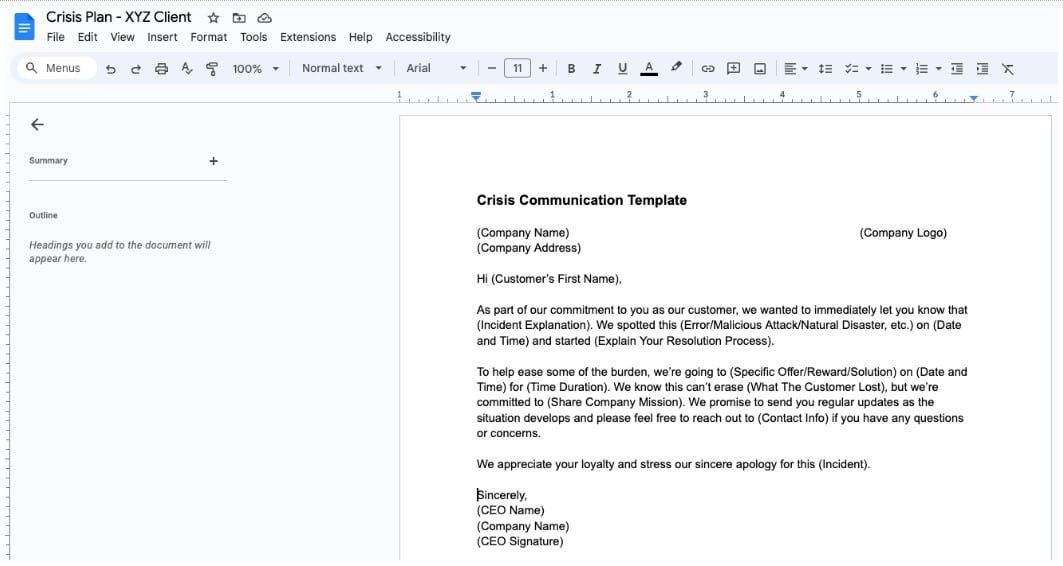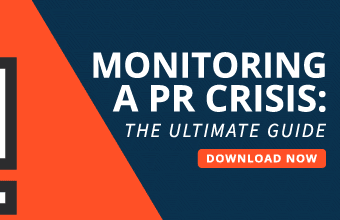One of the main traits successful PR professionals share is their ability to respond to a crisis situation.
In fact, they already know how they’re going to respond to potential crises.
This isn’t because they’ve tackled enough problems to always know what to do. It’s because they’ve put in the work to implement proactive crisis management protocols.
The truth is …
When you’re managing and protecting an individual or brand’s reputation, proactive crisis management is your best line of defense.
Let’s take a closer look at how you can develop a robust response plan for your PR clients so you can always be prepared for future crises.
Step 1: Identify potential threats
What potential risks and threats may affect your client? Conduct a risk assessment to uncover any red flags.
Be sure to also look at any previous crises they went through, too.
For instance, if you’re representing a medical organization, maybe its patients filed lawsuits in the past after their medical data got leaked. Or, worse, maybe the pharmaceutical staff made a mistake and sent patients home with compromised medications.
Add these notes to your risk assessment, including ways you would’ve handled them.
For example, for the first incident, you might’ve hired a cybersecurity expert to implement a new IT security strategy.
For the second incident, you might’ve immediately called a medical courier service to retrieve the compromised meds.
Look at potential threats from all angles — from systems to people.
Be sure to consider your clients’:
- Operational systems and technology
- Marketing and communication style
- Employees and key stakeholders
- Customer service processes
- Products and services
- Social listening stats
- Ratings and reviews
- Management teams
Step 2: Develop crisis management strategies
After considering what could go wrong for your client, take an important proactive step by creating corrective action protocols. You’ll use these strategies to tackle any crisis management problem that comes your way.
If you’re managing a high-risk client or enterprise organization, consider managing them using a larger crisis management team. This gives you more hands on deck to create more checks and balances and prevent any blind spots. Work with your team to create a protocol for each risk and threat you identified in step one.
But don’t just decide what you’ll do in times of crisis. See what proactive strategies you can implement to prevent potential crises from occurring.
For instance, if you’re representing a new enterprise-level food-service brand that targets Gen Z shoppers, you might take a close look at its packaging and carbon footprint. Gen Zers are notorious for prioritizing eco-friendly brands, so without sustainable food packaging and other green measures in place, your client could face a lot of heat.

A great place to look for insights is your client’s customers
Who are they? What problems do they face? What do they need? What are they asking for? Use social listening tools and peruse ratings and reviews to see what kind of feedback your client is receiving.
For example, if you represent a contact center software, you might encounter several comments asking for enhanced communication channels and advanced customer management tools that lower-priced competitors offer. These comments are crucial to pay attention to so your client doesn’t lose customers unnecessarily or face irate customers who don’t understand why they’re paying more for fewer features.
Encourage your client to go above and beyond for their customers by integrating their feedback whenever possible.
One last thing in this step: When your client implements a proactive measure, make sure to sing their praises from the rooftops. Send out press releases, post on social media, and email subscribers, letting them know about the new perks and features your client has released.
Step 3: Create mock statements and statement templates
Next, form your crisis communications plan. This includes how you’ll respond to stakeholders, partners, and clients in the event of a crisis.
Create mock statements so you and your team can review the style, tone, and language choices you made—but be sure to also create statement templates. This makes crisis communication faster and easier to implement without sacrificing professionalism.
Here’s an example of a template you might create:
Crisis communication template
(Company Name) (Company Logo) (Company Address)
Hi (Customer’s First Name),
As part of our commitment to you as our customer, we wanted to immediately let you know that (Incident Explanation). We spotted this (Error/Malicious Attack/Natural Disaster, etc.) on (Date and Time) and started (Explain Your Resolution Process).
To help ease some of the burden, we’re going to (Specific Offer/Reward/Solution) on (Date and Time) for (Time Duration). We know this can’t erase (What The Customer Lost), but we’re committed to (Share Company Mission). We promise to send you regular updates as the situation develops. Please feel free to reach out to (Contact Info) if you have any questions or concerns.
We appreciate your loyalty and stress our sincere apology for this (Incident).
Sincerely,
(CEO Name)
(Company Name)
(CEO Signature)
Step 4: Add your strategies and statements to a crisis plan document
Create a fresh document in Google Docs and name it “Crisis Plan – Client Name.”

Screenshot provided by the author
Format your document with formal headers and subsections (from H2s to H3s) so you and your team can easily find a section when needed.
Within specific sections, paste your:
- Identified risks and threats (including previous crises the client faced)
- New crisis management strategies
- Proactive strategies (in response to current feedback)
- Mock statements
- Statement templates
Go the extra mile by creating a new section with a business continuity plan. This is a crucial step to take if your client lives in a natural disaster zone or has an increased risk of (or history with) crises.
Train your crisis response team on this master document and make sure they have easy access to it in case of an emergency.
Wrap up
Crisis preparedness is every PR rep’s and CEO’s best line of defense.
From knowing how to address stakeholders to providing specific customer solutions, having a proactive plan in place is key to effective crisis management.
For good measure, here’s a quick recap of the steps you’ll need to take to create a robust PR response plan:
- Step 1: Identify potential threats
- Step 2: Develop crisis management strategies
- Step 3: Create mock statements and statement templates
- Step 4: Add your strategies and statements to a crisis plan document
That’s it for now, PR reps. Here’s to your success!








